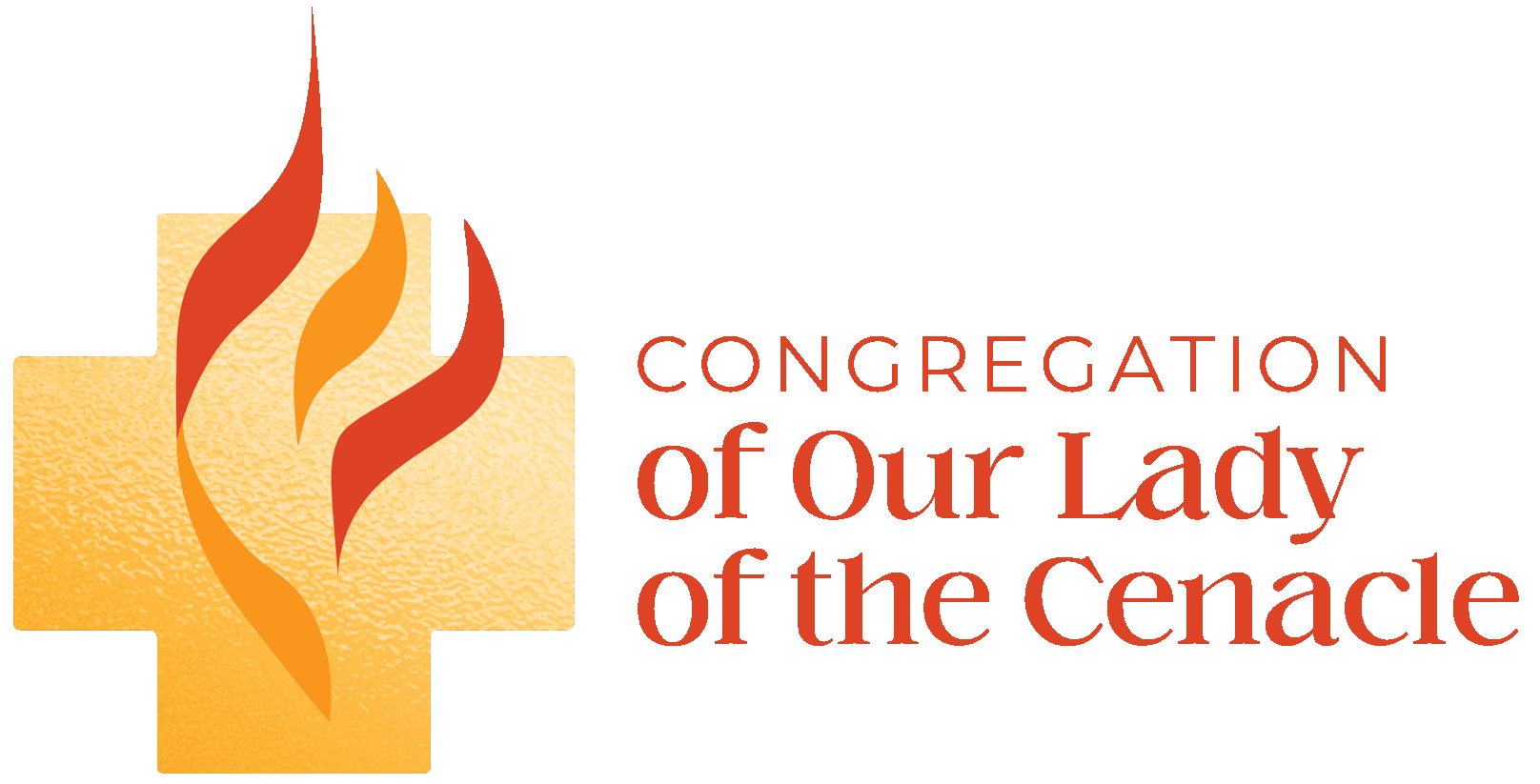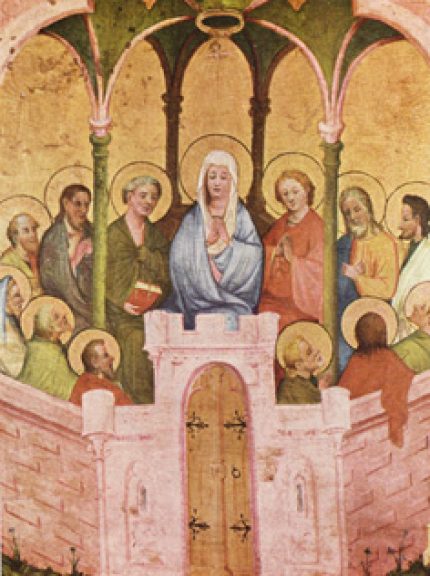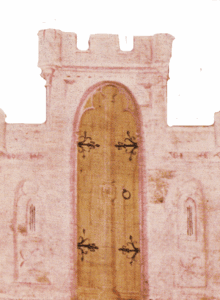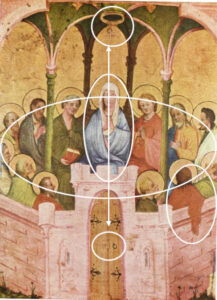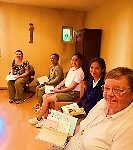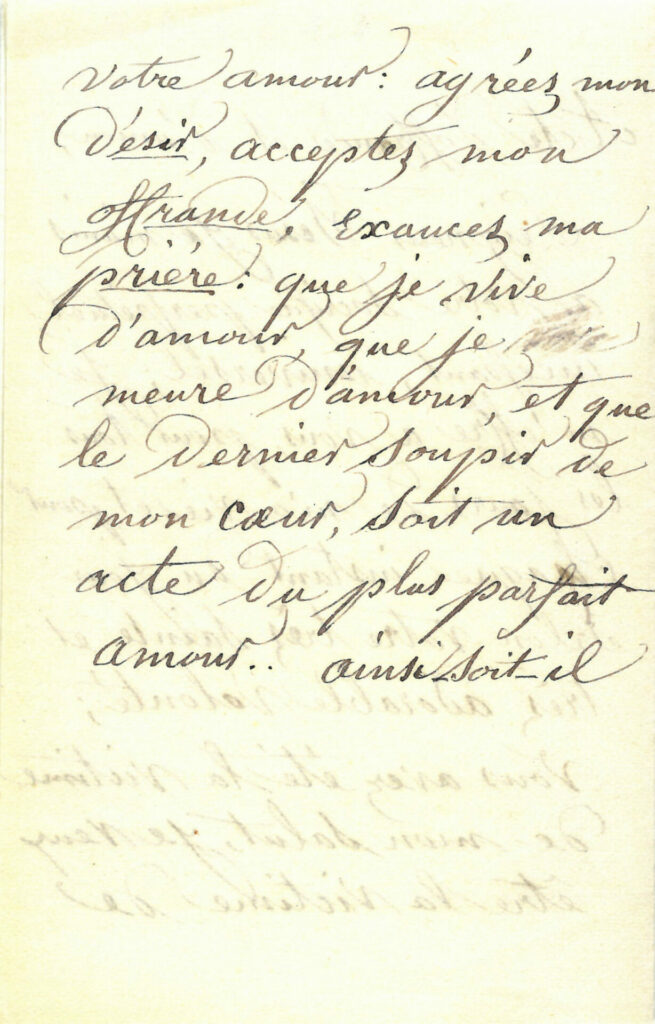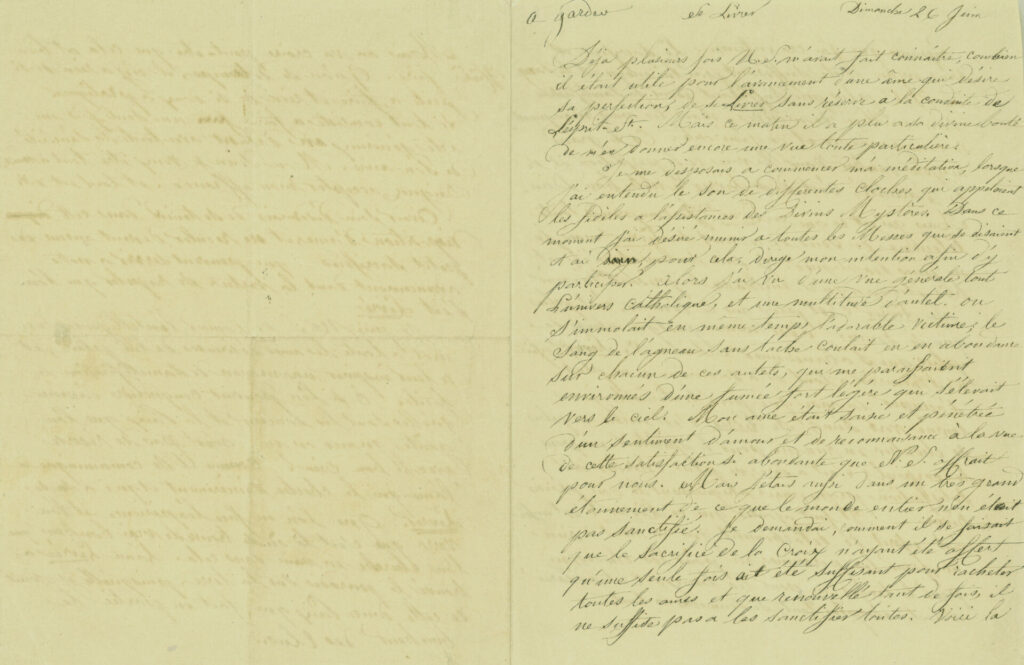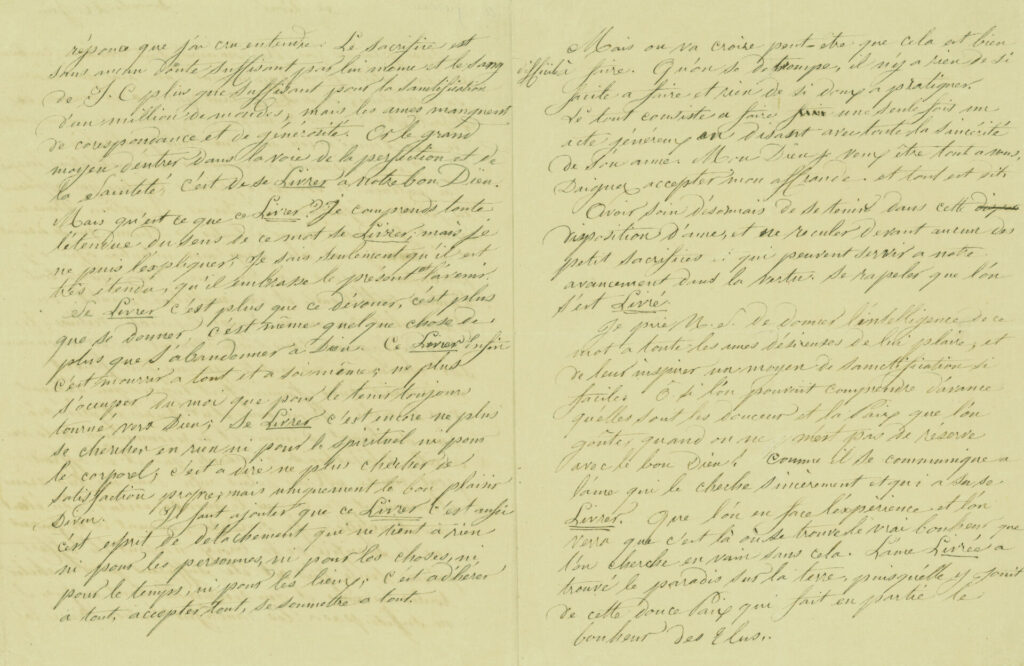The very nature of the Spirit is that it blows like the wind, without us knowing where it comes from or where it is going. Living and loving with the breath of the Spirit is akin to that freedom of movement that transcends borders and breaks down barriers. There are a great many works depicting the disciples and Mary in the Upper Room, surrounded by walls. Some of them are very discreet in the form of low walls, others have openwork walls and windows, while still others rise up like closed citadels.
.
Jesus’ disciples locked the doors
“because they were afraid of the Jews…”.[1]
.
|
. Utrecht Museum of Art, “The Descent of the Spirit” c. 1410, altar centrepiece |
.
Out of fear, they are locked in, withdrawn into themselves.
For them, who had hoped for so much, everything has just collapsed.
This Jesus in whom they believed as the Messiah,
has just been tortured, scourged, crucified and killed.
The disciples are there with Mary, stalked by fear, by their fears. But they are praying. So, all is not lost…. They have gathered in a secluded spot in the heart of the city called Jerusalem, where Jesus has just been crucified. It is true that the city is fortified, but the crenellations, mullions, and other fortress-like features of some of the illuminations are not archaeological details but a spiritual message that needs to be deciphered by looking closely.
.
In the Cenacle, “the doors were shut for fear of the Jews,” so Jesus came and stood among them and said to them, “Peace be with you.” When he had said this, he showed them his hands and his side. The disciples were filled with joy at the sight of the Lord. Then he said to them again, “Peace be with you! As the Father has sent me, so I send you. When he had said this, he breathed on them and said, “Receive the Holy Spirit. Whose sins you forgive, they are forgiven them; whose sins you retain, they are retained. “[2].
In John’s Gospel, this passage takes place a few verses before the appearance to Thomas. The Risen Christ makes himself present, visible, audible and perceptible to the senses and gives his disciples the breath of his Spirit and Peace. This apparition of Christ to his disciples took place in the Cenacle in Jerusalem before the Ascension, but neither the Gospels nor the Acts of the Apostles state that the doors of the Cenacle were closed for fear of the Jews at the very moment of Pentecost. However, some artists, such as is the case in this altar centrepiece from Utrecht, combine all the events that take place between Easter and Pentecost, and summarise the scene by depicting the apostles and Mary, gathered in the Cenacle with the doors closed, receiving the Holy Spirit, while Christ, who has returned to the right hand of the Father, is definitively absent.
|
Altar centre, Utrecht, 15th century |
The pink stone ramparts of the Utrecht painting, with their monumental wooden gate solidified by extensive wrought ironwork, loopholes, battlements, and watchtowers, resemble a fortified castle. |
.
..The disciples locked themselves in out of fear, barricaded themselves in, walled themselves in because:
.
.
“This small handful of people
are nothing more than survivors.
They are the last witnesses to an adventure that is over and that ended badly.
All they have left to survive are a few square metres squeezed between four walls:
its their only legacy.
All they have to breathe are regrets
and memories to feed on.
Their hiding place is a prison,
their home is a tomb.”[3]
.
.
The spiritual symbolism is strong.
It speaks of the disciples who shut themselves away for fear of the Jews, but by extrapolation, it also speaks of those who are walled in by their fear of others, who jump at the slightest noise and who are trapped by their anxieties; shipwrecked people who are afraid to die, the living dead who look at life with disillusioned eyes, pitiful people who groan without the hope of a better future. It also speaks of those who take refuge in a protective cocoon, who revel in merging with their fellow human beings, in the contemplation of mirrors reflecting their image in reassuring cloning, who dare not bet on the future, nor risk moving forward, facing the unknown, living and loving. It denounces the Church in its moments of frigid withdrawal, in its rejection and fear of the world, the different, and the unknown.
.
” Opening the door means giving a face. It is a gamble.
An encounter is always a risk. The Spirit is that risk.
Those whose doors are locked are those who have eliminated this risk.
They are so closed in on themselves that they are a universe unto themselves.
They no longer have problems with borders because they no longer have doors or windows, only mirrors in which they never tire of taking themselves for the whole world.” [4]
.
Admittedly, in this work depicting the Upper Room, the disciples have shut themselves behind walls, for fear of the Jews, for fear of others who have become dangerous, for fear of friends who have become enemies… but a few details show that they are not so closed in on themselves as to shun all contact with the outside world.
.
There are two astonishing details in Utrecht’s work.
.
First, the lock on this door is not made of metal. It is as if it has been dismantled and only a trace of it remains. So, is there no longer any need for a key to enter this fortress? Have the doors, locked by fear, been unlocked? Would the lock and the fortified ramparts be no more than vestiges, the stigmata of an attitude that had become obsolete but whose trace would remain?
.
On the other hand, a clearly visible knocker allows one to knock to announce one’s visit or beg for hospitality. Those who, at first glance, might have barricaded themselves in a fortress are revealed by these two details to be accessible.
.
Two other aspects would tend to suggest that fear has indeed been erased by grace, by the breath of the Spirit that sets hearts on the open sea.
The first is to be found in the very structure of Utrecht’s work:
|
Utrecht, centre of the altarvers 1450 |
While the disciples are arranged in a circle within the fortified walls of the upper room, a spiral-shaped circle dictated by the constraints of perspective, Mary is at the centre of the composition. Standing upright, hieratic, her hands clasped, she forms a link between the keystone, from which the Holy Spirit springs in the form of a dove, and the monumental door surmounted by battlements, with its ring-shaped knocker and ghost lock. When Jesus appears to the disciples to give them the Spirit, the doors are closed. Here, Jesus is no longer present; only his Spirit is given. In the form of a golden dove, the Spirit emerges from above, above Mary, beneath a keystone in the colours of darkness, light bursting forth from the darkness, hope emerging from sadness, a breach in the impasse. The keystone, which ensures the stability and solidity of the arches, becomes a symbolic key opening a passageway between heaven and earth so that the Holy Spirit can descend into the Virgin Mary, sow the seed of the Church and break the lock that renders it infertile. |
.
The symbolism could be daring if the image did not transcend the message by revealing itself only very discreetly through the imprint of a lock placed in relation to Mary, the dove of the Spirit and the keystone, placed in the same verticality. All the more so since Mary is no longer the image of the woman who gave birth to Jesus, but that of the Church being born with the breath of the Spirit. An icon of the nascent Church, here she is impregnated in a new way. Freed from the locks of fear provoked by the death of Jesus, its door will become a passageway, a holy door offering refuge and hospitality to those who seek God, a door opening wide its casements to the disciples setting out to announce to the whole world that Christ is risen.
Here, however, the door is not yet open, only the lock has been unlocked.
The signs we see are only the first signs…
.
The second aspect that tends to suggest that fear and withdrawal no longer dominate the apostles at prayer is the red cloak of one of them, on the right of the illumination. This part of the cloak extends beyond the closed room and hangs outside the rampart. This detail might seem insignificant or secondary were it not so ostensibly deliberate. The disciple carrying it is depicted with his back turned to the viewer of the work, as well as to anyone who might venture to use the knocker. His posture makes him turn his back on everything outside the comfort of the Upper Room at prayer. His posture suggests that he refuses or rejects this dangerous world that has put the Messiah to death. But the flap of his cloak tells us that a breath is blowing through him and taking him where he does not want to go or cannot go yet. His red cloak hangs over the rampart like a banner. Like a flag, it beckons to the outside world and opens the wearer up to the great spaces of the Spirit without him being aware of it. He still has his back to the world, but a part of him is open to it.
Prayer has opened a breach.
Sr. Ghislaine Pauquet r.c.
Une brèche pour l’EspritA breach for the Spirit
.
.
The disciples of Jesus are holed up like rats. Going through the doors was out of the question: they were “locked” by fear.
.
In an atmosphere oozing with anxiety “because they were afraid of the Jews…” these people startled by the slightest noise, these shipwrecked people on their raft, these trapped escapees, these condemned to death on probation, these dog-eat-dog looks, these worried Christians, these believers under fear, this religion of fear, whispering in the shadows.
.
This small handful of people are nothing more than survivors. They are the last witnesses to an adventure that has come to an end and ended badly. All they have left to survive are these few square metres squeezed between four walls: it is their only legacy. Their hiding place is a prison, their home a tomb.
.
The man they had bet everything on was caught, betrayed and tortured. It is all a failure, not even glorious, just lamentable. Jesus is dead.
.
Then, “Jesus came and he was there among them…”.
There is no transition, no parenthesis. God is urgent. Life does not wait.
.
The resurrection is always a birth, a wrench, a tear.
Resurrection does not plan ahead, pay in monthly instalments, draw up a savings plan, or have a checklist. The action of the Spirit is not planned; it is sudden. He said to them, “Receive the Holy Spirit…”
.
Suddenly, the world stops looking in the mirror and taking itself for its own image. The world opens its windows and draws its curtains. There is a breach, and through that breach, the world begins again.
.
The last survivors of the dead adventure become the first witnesses of birth. The last are the first. It is no longer the end of one world, but the beginning of another. The Gospel begins when one world is finished. The disciples are no longer fugitives, but envoys: “I also am sending you…”
.
.
The locked door becomes a path, the prison becomes a road to freedom, the hunted by fear “are filled with joy…” And yet these are the same people, the same poor people, the same poor men and women. The same and yet so different. They are the same, but they have become so different.
.
This is Pentecost.
“Receive the Holy Spirit…”.
This is Pentecost.
.
To open a door is to dare to face a distance, a newness, a new space, a draught, a stranger who does not yet have a face. All I know is that he is knocking on the door and waiting.
.
Opening the door will mean giving it a face. It is a gamble.
An encounter is always a risk. The Spirit is that risk.
.
Those whose doors are locked are those who have eliminated this risk.
They are so closed in on themselves that they are a universe unto themselves.
.
They no longer have problems with borders because they no longer have doors or windows, only mirrors in which they never tire of taking themselves for the whole world.
.
Contrary to what people would have us believe, the Holy Spirit does not abolish borders: he opens them and creates new ones. There are still too many people who dream of standardising the unity of the world on the basis of mass production, where everyone would come out of the same mould, on the same model.
.
It is true that with good feelings and a bit of atmosphere we can feel “close” or “united,” but all we are ever doing is cheating distances.
The people of Babel already wanted to do away with distances. Babel is the opposite of Pentecost.
.
.
Those who speak so well of “totalising” the world are generally “totalitarians.”
The Spirit is not the Spirit of a system. The action of the Spirit is to be different.
If I want to meet the other, it is to the extent that the other is not me!
.
.
Jean Debruynne
Ouvrez, coll. Mille textes,
Paris: P.U.F., 2000, p. 186-189
.
.
.
